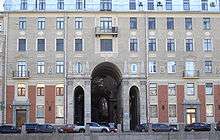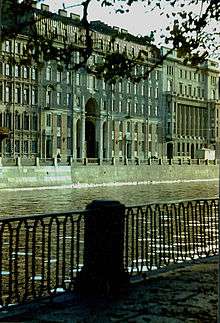Tolstoy House
The Tolstoy House is a large and well-known apartment building in St. Petersburg, located at 15-17 Rubinstein Street and 54 Fontanka Embankment. The building was designed by Fyodor Lidval[1] in National Romantic style[2].

The building was constructed in 1910–1912 under the aegis of Major-General Count Mikhail Pavlovich Tolstoy,[3] nephew of the 1812 war hero P. A. Tolstoy. After Tolstoy's death in 1913, ownership devolved to his widow Countess Olga Tolstoy (born a princess of the Vasilchikov family, daughter of Prince Alexander Illarionovich Vasilchikov, a second in the famous 1841 duel between Mikhail Lermontov and Nikolai Martynov).[4]
Architecture
| Wikimedia Commons has media related to Tolstoy House. |

The building design shows elements typical of the creative work of Fydor Lidval: high Renaissance arches, balconies on the upper floors, restraint and refinement of decorative elements, respect for comfort, and an eye for natural lighting.[5]
From the first, the building was provided with a laundry, plumbing, and elevators. The structure was conceived as a home for all classes, with apartments for people of all incomes, from modest to luxurious.[5]
The complex layout of the building includes a sequence of three connected arched courtyards leading from Rubinstein Street to the embankment of the Fontanka River. The facades of the three main courtyards are decorated as carefully as the front of the building (although on either side of the building are less decorated courtyards into which the back doors of the apartments open). The facades use hewed limestone, brick, and stucco.[5]
In the central courtyard there was a Roman-style fountain designed and built by Lidval. This fountain was in place until the 1950s but was completely lost by the 1990s.[5]
Initially, there were passages in the center of the courtyards, and a small lawn which occupied only a very narrow strip along the original streets. In Soviet times, the appearance was significantly altered: in the middle of the yard, driveways were made, the lawns were planted with poplars, and a statue was installed in the fountain. Thus was lost Lidval's original concept of an internal street.[5]
Architectural monument
In 2008, the house was made a protected art and cultural monument under the aegis of the HOA. In 2009, Marina Kolotilo was made chairman of the HOA Tolstoy House. HOA is making efforts to repair, restore, and preserve the Tolstoy House. Kolotilo has begun an effort to establish a museum in the Tolstoy House and is preparing a program celebrating its 100th anniversary.
The building is designated an Architectural Monument of Regional Significance (number 7800770000). It is part of UNESCO World Heritage Site number 540, Historic Centre of Saint Petersburg and Related Groups of Monuments.[6] In 1988 it was given additional protected status as part of the Joint Security Area of St. Petersburg. However, in 2008, after reducing the buffer zone, the status of the building has been downgraded to Zone Controlled Building.
In cinema
The Tolstoy House appears as a setting in several Russian films. Most of Igor Maslennikov's 1985 film Winter Cherries takes place in the Tolstoy House, in its yards, or near it. In this film, the Tolstoy House serves as a kind of actor itself, playing up to the stars of the film and creating a certain mood. Maslennikov also used the Tolstoy House in his The Adventures of Sherlock Holmes and Dr. Watson series of television films to stand in for parts of Holmes's London.[7] Other films using the Tolstoy House include A Doctor Called?, You Never Dreamed Of..., Born of the Revolution, and Gangster Petersburg.
Famous residents
Past residents
- A. I. Kuprin (1870–1938), writer. Trained at the "Sanitas" athletic club located in the building, and may have lived in the building.
- A. I. Spiridovich (1873–1952), Major General, Chief of the Imperial Palace Guards. He lived in apartment 333. After the October Revolution he went into exile, where he wrote several books of memoirs and studies of Russian political parties. He died in New York City.
- A. T. Averchenko, writer, satirist and a theater critic. Averchenko lived in the building in the years 1914-1917, in apartment 203.
- Alexander Belosludtsev (1961–2004), painter, graphic designer, and photographer, editor of a six-volume collected works of Anna Akhmatova.
- Boris Z. Kraychik (born 1928; deceased), engineer and writer, author of the children's book What Happened at the Hermitage, friend of Igor S. Kon and S. D. Dovlatov.
- C. M. Alyansky (1891–1984), owner and editor of the Symbolist publishing house Alkonost. Alyansky lived in the building in 1919.
- E. B. Rein (born 1935) poet and disciple of Anna Akhmatova who was included in the 1960s group "Akhmatova's Orphans". Members of his circle who visited him at Tolstoy House included Akhmatova, D. Monakhov, V. Britanishsky, S. Dovlatov, J. Brodsky, A.Naiman, G. Gorbovsky, and A. Kushner.
- Ekaterina Panzhenskij (1984–2009), designer and photographer. She created a series of photographs of the Tolstoy House, many portraits of artists and musicians (e.g. Nikas Safronov, M. S. Vspyshkin), and several book covers. She lived in apartment 263.
- Galina Kremshevskaya (Saint George-Kremshevskaya) (1912–1996), dancer and ballet critic, wife of Michael S. George. Author of books on the Vaganova Academy of Russian Ballet (which she attended) and the outstanding ballerinas T. M. Vecheslovoy and N. M. Dudinskaya.
- M. B. Polyakin, violinist and educator, lived in the house in the years 1928-1936.
- M. V. Manevich, vice-governor of St. Petersburg (1996–1997). Lived in the building until his murder in 1997.
- Michael S. George (1935–1958), ballet dancer and director (1958–1976) of the Kirov Opera and Ballet Theater.
- P.M. Benyash (1914–1986), Soviet-era drama and theater critic.
- Prince Mikhail Mikhailovich Andronicus (1875–1919), famous adventurer and member of Rasputin's circle. He was evicted from the Tolstoy House in 1916 by court decision following a lawsuit by the landlady (Countess Tolstoy), who did not like Rasputin and his followers visiting the building.
- Puryshev Arkady Konstantinovich, hereditary honorary citizen, businessman, monarchist, prominent collector. His wife and daughter were members of the Union of Russian Women. According to the memoirs of his adopted grandson (son of his stepson), the writer L. Panteleyev, he lived in the Tolstoy House.
- S. G. Kalmanovich (1947–2009), businessman and sports manager.
- Tatyana I. Satz (Kolesnikova) (born 1964), world-class gymnast, coach of the Leningrad gymnasts (1984–1990). Silver medalist of the world, two-time champion of the USSR, five-time champion of Leningrad. Lived in Tolstoy House in the 1990s.
- V. Knyazev (Sedykh) (1887–1937), poet and revolutionary. A writer of satirical topical poems and author of the lyrics to the song March of the Commune (chorus: "Never, never, never, never will we be slaves to the commune...", inspired by the lyrics of the British anthem Rule Brittania). Before his arrest he lived in apartment 301.
- Vitaliy Dmitrievich Sobol (1934–1997), journalist, writer, historian of the city of St. Petersburg. He lived in the Tolstoy House as a child.
- Vladimir G. Garshin (1887–1974), professor, pathologist, academician of the Academy of Medical Sciences (1945), a nephew of Vsevolod Garshin and a friend of Anna Akhmatova. He lived in apartment number 459 during the Siege of Leningrad, as the chief pathologist of Leningrad.
- Zoya Petrovna Samoletov (1930–1999), twice member of the Supreme Soviet, member of the Council of the Union, seamstress and Brigadier of the Bolshevichka garment production association. Lived in the Tolstoy House in the 1940s and 1950s.
- Eduard Khil, singer most famously known for appearing in the "Trololo" video, which was recorded in 1968 and later went viral in 2009.
Recent and current residents
- Andrey Petrovich Gagarin (1934—2011), doctor of technical sciences, professor at STU, a descendant of the princes Gagarin and chairman of the St. Petersburg branch of the provincial nobility.
- Bella Moiseyevna Kupsina, producer for Alexander Rosenbaum.
- Irina Kolpakova (born 1935), ballerina. She has been active in the effort to preserve the historical appearance of the Tolstoy House.
- Marina Kolotilo (born 1963), art historian and cultural scientist, member of the International Association of Art Critics, member of the Russian Geographical Society, chairman of the HOA Tolstoy House.
- Mariss Jansons, conductor.
- V. G. Semyonov (born 1932), dancer, teacher, People's Artist of the USSR. He lives with his wife Irina Kolpakova in the Tolstoy House.
- Vladimir Kehman, director of the Mikhaylovsky Theatre.
- Vladimir Kiselev, producer of the band Zemlyane.
References
- Isachenko, V. G. Architecture of St. Petersburg (Архитектура Санкт-Петербурга). 2004, Parity. ISBN 5-93437-125-8 (in Russian)
- Kirikov, Boris (2014). Architecture of Art Nouveau in Saint Petersburg. Estates and Tenement Houses (in Russian). Saint Petersburg: Kolo. pp. 465–474. ISBN 978-5-4462-0044-3.|note}}
- Tolstoy House in St. Petersburg (1910-1912), architect FI Lidval, and its first owner, Count Mikhail Pavlovich Tolstoy, stateyki.org.ua (in Russian)
- Lermontov's duel with NS Мартыновым Martynov, ruslibrary.ru (in Russian)
- Galkina, G. (2016-02-17). "Я живу в Толстовском доме (Петербург)" [I live in the Tolstoy house] (in Russian). The Village. Retrieved 2020-02-25.
- Centre, UNESCO World Heritage. "Historic Centre of Saint Petersburg and Related Groups of Monuments". whc.unesco.org.
- 15-17 Rubinstein Street in the film "The Adventures of Sherlock Holmes and Doctor Watson" (in Russian)